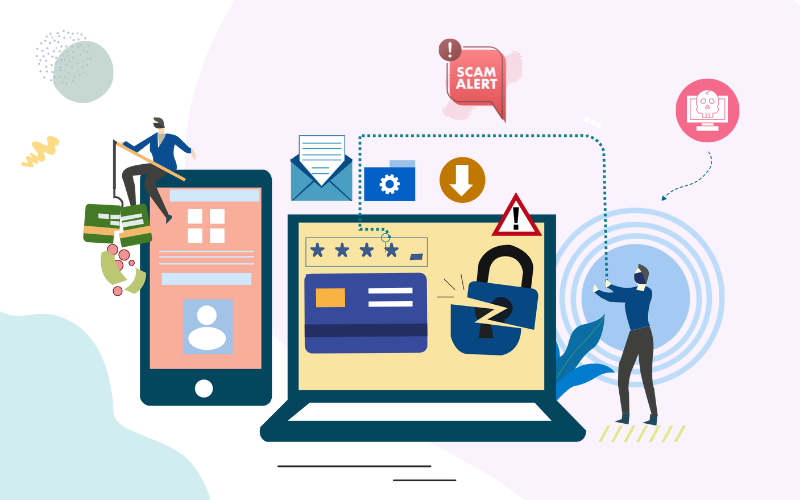


Identity theft is one of the fastest-growing crimes in the world, and the rise of digital technologies has made it easier for scammers to steal your personal information. Whether it’s through phishing emails or fraudulent phone calls, identity theft scams are becoming increasingly sophisticated. In this blog post, we will explore 10 of the most common identity theft scams to help you stay informed and protect your personal data.
Phishing is one of the most widespread forms of identity theft. Scammers send fake emails or text messages that appear to be from legitimate organizations, such as banks or government agencies, to trick you into sharing personal information like passwords, Social Security numbers, or credit card details. These scams often contain a sense of urgency, pushing you to act quickly before you have time to think.
How to protect yourself:
Never click on suspicious links or provide personal information through email. Always verify the source before responding.
Vishing, or voice phishing, occurs when a scammer contacts you via phone, pretending to be from your bank, the IRS, or a trusted company. They use fear tactics, such as claiming there’s been fraudulent activity on your account, to extract personal details like credit card numbers or Social Security information.
How to protect yourself:
If you receive a suspicious call, hang up and contact the organization directly through an official phone number to verify the claim.
With so much personal information shared online, social media platforms have become a goldmine for identity thieves. Scammers create fake profiles, send phishing messages, or use quizzes and contests to collect sensitive data, such as birthdates, home addresses, and even security question answers.
How to protect yourself:
Be cautious about the information you share on social media, and avoid accepting friend requests from people you don’t know.
Mail theft is a more traditional but still effective way for criminals to steal your identity. By snatching your mail, thieves can get their hands on sensitive documents like bank statements, credit card offers, and tax forms.
How to protect yourself:
Shred important documents before discarding them, and consider using a locked mailbox or a P.O. box to receive sensitive mail.
Large-scale data breaches are becoming more common, exposing the personal information of millions of people at once. Hackers target companies, stealing everything from email addresses to credit card numbers, Social Security numbers, and more.
How to protect yourself:
Monitor your accounts regularly for suspicious activity, and consider signing up for a credit monitoring service to receive alerts about potential fraud.
Tax identity theft occurs when a fraudster uses your Social Security number to file a fraudulent tax return in your name and claim a refund. Victims usually discover the scam when they attempt to file their own taxes and find that a return has already been filed.
How to protect yourself:
File your taxes as early as possible to beat scammers to the punch, and be wary of any communications claiming to be from the IRS.
Credit card skimming involves placing a device on an ATM or gas station pump that captures your card information when you swipe. The scammer can then clone your card and make unauthorized purchases.
How to protect yourself:
Inspect ATMs and gas pumps for any suspicious devices before using them, and consider using mobile payment options instead of physical cards.
Some identity thieves create fake online stores that offer too-good-to-be-true deals. When you make a purchase, they collect your credit card information and personal details, but the product never arrives.
How to protect yourself:
Always research online stores before making a purchase, and look for secure website markers like “https://” in the URL and trust seals from reputable security firms.
SIM card swapping occurs when a scammer convinces your mobile carrier to switch your phone number to their SIM card. Once they have control of your phone number, they can bypass two-factor authentication and access your financial and online accounts.
How to protect yourself:
Contact your mobile provider and ask for additional security measures to prevent unauthorized SIM swaps, such as adding a PIN to your account.
In this scam, a thief uses your personal information to receive medical treatment or prescription drugs. You may not realize it until you receive a bill for services you didn’t receive, or your insurance company denies your claim because your benefits have been maxed out.
Review your medical records and insurance claims regularly to spot any discrepancies, and report any suspicious activity immediately. Here’s how to protect yourself from identity theft scams:
Identity theft scams are constantly evolving, and staying informed is your first line of defense. By recognizing the common scams listed above, you can take proactive steps to protect yourself and minimize the risk of falling victim to identity theft. Remember, vigilance and caution are key to keeping your personal information secure in an increasingly connected world.
Copyright © 2025 ・ SafeIDWatch ・ All Rights Reserved